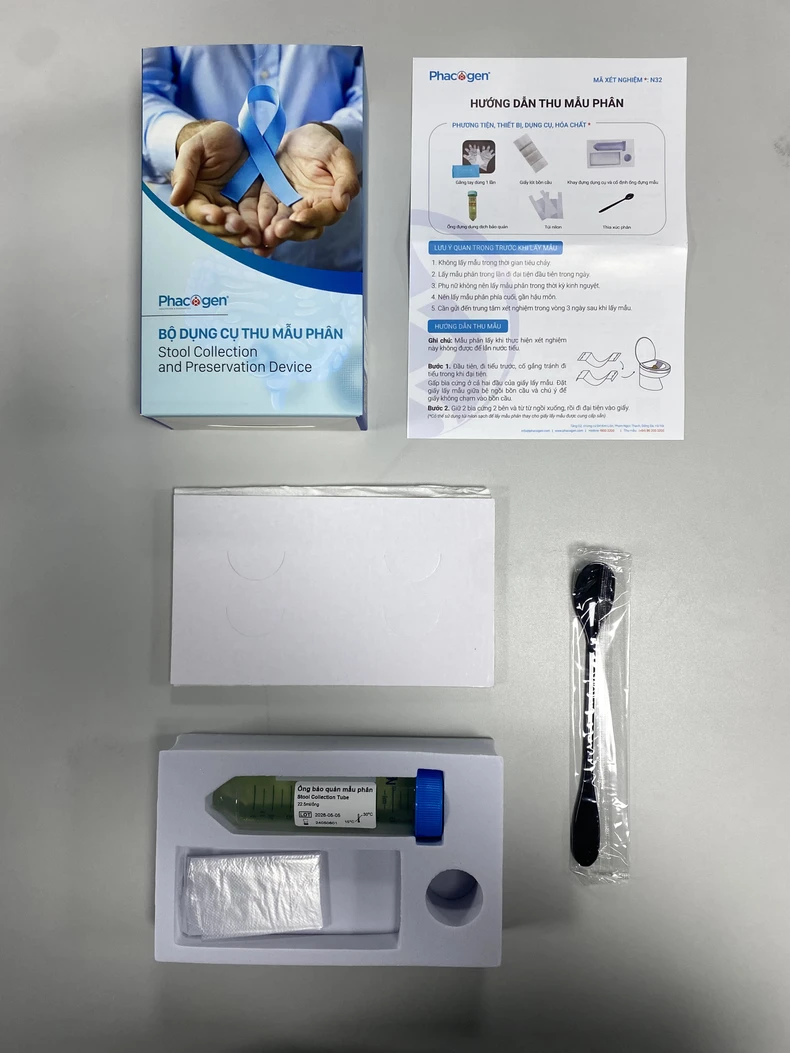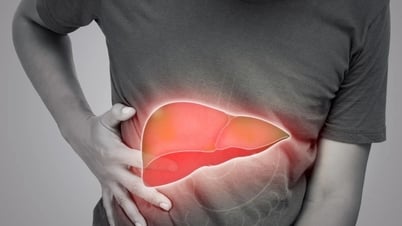Effectiveness of non-invasive screening methods
Specialist Doctor I Vu Tran Minh Nguyen, Tam Anh General Hospital, Ho Chi Minh City said that according to Globocan 2020 (cancer database of the International Agency for Research on Cancer), in Vietnam, there are over 6,000 new cases of colon cancer and over 9,000 new cases of rectal cancer detected each year. At the same time, colon - rectal cancer is in the group of 10 cancers with the highest annual mortality.
When colorectal cancer is detected in its early stages before it has spread, the five-year survival rate is about 90%. In fact, only about 4 out of 10 cases are diagnosed at this stage. Once the cancer has progressed, the survival rate is lower.
Today, advances in science have brought new cancer screening methods with higher efficiency and accuracy. Colorectal cancer screening methods are divided into two main groups: Screening group by imaging : colonoscopy - rectum, CT scan; Screening group through stool tests : fecal occult blood test (gFOBT), fecal immunochemistry (FIT), fecal DNA (mt-sDNA).
According to specialist doctor Vu Tran Minh Nguyen, there are currently 3 types of non-invasive colorectal cancer screening tests and this is a method that people are interested in because it can be implemented early, requires simple sampling and does not require invasive procedures.
The first is the gFOBT (Guaiac Fecal Occult Blood Test). This is a traditional method to detect blood in the stool, using a colored indicator paper and some chemicals such as hydrogen peroxide, Guaiac resin. The blood will turn the indicator paper blue.
Stool collection kit for colorectal cancer testing from Phacogen Institute of Technology. |
The second method is the FIT (Fecal Immunochemical Test) - a technique that detects hemoglobin protein (a component of human red blood cells). The FIT test has an advantage over the traditional gFOBT because the test results are less affected by the patient's diet.
Specialist Doctor I Vu Tran Minh Nguyen noted that some cases of colorectal cancer do not cause bleeding or do not bleed at the time of stool testing. At the same time, benign digestive diseases such as Crohn's disease, ulcerative colitis, etc. can also cause bleeding. Therefore, tests for occult blood in stool should be performed periodically to increase the ability to detect the disease, and patients need a colonoscopy to accurately determine if abnormalities are suspected.
Third is the mt-sDNA (multi-target stool DNA) test, which identifies several biomarkers or stool markers associated with colorectal cancer and advanced adenomas. The mt-sDNA test is more accurate than tests for occult blood in the stool. However, when the test results are abnormal, the patient still needs a colonoscopy for a definitive diagnosis.
Associate Professor, Doctor Nguyen Cong Hoang, Member of the 15th National Assembly, Director of Thai Nguyen Central Hospital, said that according to research results, the ability to detect colorectal cancer based on these tests for hidden blood in the stool is up to more than 90%. Investing in highly accurate testing methods that meet CE-IVD standards and strict quality control is an important foundation to help doctors make timely and correct clinical decisions.
Proposal to introduce non-invasive colorectal cancer screening methods into community screening
One of the reasons why people are often reluctant to go for medical check-ups is that invasive diagnostic methods often involve anesthesia or inserting instruments and machines into the body. This is a barrier that prevents some people from wanting to go for medical check-ups.
Therefore, Associate Professor, Doctor Nguyen Cong Hoang believes that the Vietnamese health sector needs to deploy non-invasive diagnostic methods with high accuracy rates to encourage people to go for medical examinations.
"To screen for colorectal cancer in the community, priority should be given to applying non-invasive, easy-to-implement, and cost-effective screening methods. To deploy on a large scale, especially in rural areas or in populations that do not have access to high-quality healthcare, we need solutions that are both easy to implement and highly accurate, such as fecal DNA testing. This is a method that can be completely integrated into a large-scale community screening program without putting pressure on the healthcare system," Associate Professor Hoang suggested.
Also sharing about this, Associate Professor, Dr. Pham Cam Phuong, Director of the Center for Nuclear Medicine and Oncology, Bach Mai Hospital expressed his hope that in the near future, Vietnam will have advanced techniques in the world to classify which patient groups are at high risk, very high risk,... based on the results of the fecal occult blood test or the assessment of mt-sDNA status. From there, the very high risk group can be classified to continue to screen this subject by colonoscopy, helping to diagnose the disease early.
Experts shared at the seminar "Screening, diagnosis and treatment strategy for colorectal cancer in Vietnam" recently organized by Nhan Dan Newspaper in collaboration with Phacogen Institute of Technology. |
Associate Professor, Doctor Vu Van Khien, General Secretary of the Vietnam Gastroenterology Association, said that currently, colorectal cancer screening methods are divided into 3 levels: Level 1 for normal people, level 2 for risk, level 3 for high risk. People at high risk do not depend on age but depend on many factors such as genes, heredity, lifestyle, diseases... Therefore, early screening and screening for subjects is very important.
This expert also hopes that the Government will support the Ministry of Health in introducing a strategy of using non-invasive screening tests in the community. "Korea, China, and Japan have implemented this screening. In the country's development strategy, we should also implement non-invasive testing to implement large-scale colorectal cancer screening," Associate Professor, Dr. Vu Van Khien expressed.
Colorectal cancer screening with imaging
Colonoscopy is considered the “gold standard” in colorectal cancer screening because this method allows doctors to observe the inner surface of the colon and rectum. Through endoscopy, doctors can detect abnormal lesions in the colon and rectum and determine the location, size, and surface properties of the lesions.
Computed tomography (CT) scan, also known as virtual colonoscopy, is a method that uses X-rays and a computer to create images of the colon and rectum. It should be noted that CT scans may not detect lesions or polyps that lie flat against the colon and rectum mucosa. When a suspicious lesion is detected on a CT scan, the patient needs a colonoscopy to directly observe the lesion and biopsy/remove it if necessary.
Source: https://nhandan.vn/tam-soat-ung-thu-dai-truc-trang-bang-phuong-phap-khong-xam-lan-hieu-qua-the-nao-post879708.html




![[Photo] More than 17,000 candidates participate in the 2025 SPT Competency Assessment Test of Hanoi National University of Education](https://vphoto.vietnam.vn/thumb/1200x675/vietnam/resource/IMAGE/2025/5/17/e538d9a1636c407cbb211b314e6303fd)
![[Photo] National conference to disseminate and implement Resolution No. 66-NQ/TW and Resolution No. 68-NQ/TW of the Politburo](https://vphoto.vietnam.vn/thumb/1200x675/vietnam/resource/IMAGE/2025/5/18/adf666b9303a4213998b395b05234b6a)



![[Photo] Prime Minister Pham Minh Chinh chairs meeting on science and technology development](https://vphoto.vietnam.vn/thumb/1200x675/vietnam/resource/IMAGE/2025/5/17/ae80dd74c384439789b12013c738a045)














![[Photo] National conference to disseminate and implement Resolution No. 66-NQ/TW and Resolution No. 68-NQ/TW of the Politburo](https://vphoto.vietnam.vn/thumb/402x226/vietnam/resource/IMAGE/2025/5/18/adf666b9303a4213998b395b05234b6a)




![[Photo] Readers line up to visit the photo exhibition and receive a special publication commemorating the 135th birthday of President Ho Chi Minh at Nhan Dan Newspaper](https://vphoto.vietnam.vn/thumb/1200x675/vietnam/resource/IMAGE/2025/5/17/85b3197fc6bd43e6a9ee4db15101005b)

































































Comment (0)